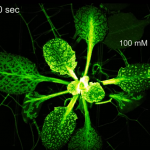Definition
noun
(botany)
(1) A plant that utilizes the C3 carbon fixation pathway as the sole mechanism to convert CO2 into an organic compound (i.e. 3-phosphogylycerate).
(2) A plant in which the CO2 is first fixed into a compound containing three carbon atoms before entering the Calvin cycle of photosynthesis.
Supplement
C3 plants involve direct carbon fixation of CO2. That is, the initial steps involve the CO2 being bound to ribulose bisphosphate to produce two molecules of three-carbon compound (i.e. 3-phosphogylycerate). The key enzyme that catalyzes carbon fixation is rubisco.
C3 plants must however be in areas where CO2 concentration is high, temperature and light intensity are moderate, and ground water is abundant. This is because in hot areas, the stomata are closed to prevent water loss. However, it results in the rise of O2 level. When this occurs, rubisco reacts with O2 instead of CO2, and leads to photorespiration, which in turn, causes wasteful loss of CO2 in C3 plants.
Examples of C3 plants include most broadleaf plants and plants in the temperate zones.
Compare: C4 plant, CAM plant.
See also: C3 carbon fixation pathway, Calvin cycle.
Dictionary > C3 plant








